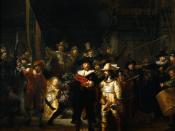Born on July 15, 1606 in Leiden, Netherlands, Rembrandt Haarmenson Van Rijn was a Dutch Painter, draftsmen, and etcher during the 17th Century. He was considered a giant in the history of art. His paintings are known for their lavish brushwork, rich color, and a mastery of chiaroscuro. His drawings portray primarily Amsterdam life. Known as the greatest artist of the Dutch School, he was a master of light and shadow and it is readily apparent in his work. (Pioch). It was his use of extreme light to dark contrast values that created interesting effects not being utilized by other painters.
Rembrandt was not always destined for the art world. His father had the expectation that his son would take up a learned profession. Rembrandt, however decided to leave the University of Leiden and elected to study painting. In Rembrandt's earlier years his work showed lines, light and shade, and the color of the people he noticed around him.
He emphasized action, drama, and a high contrast between light and dark. (Pioch).
As his work matured it would take on a mellower, more contemplative character. He also began to incorporate warmer, brighter colors. He was able to subtly blend his reflected thoughts and feelings in many of his painting depicting scenes (Pioch).
There are many choices when examining Rembrandt's work since he utilized many techniques and mediums. In Sleeping Woman (1660-1669), he provides an excellent example of why many artists prefer drawing with a brush. The reason artists prefer the brush over other tools is that it affords them a sense of immediacy and spontaneity. A Sleeping Woman makes that clear, because "the work seems so spontaneous, so quick an impetuous, that one can imagine Rembrandt drawing the scene quickly, so as not to wake the woman (Sayre 209)."...


